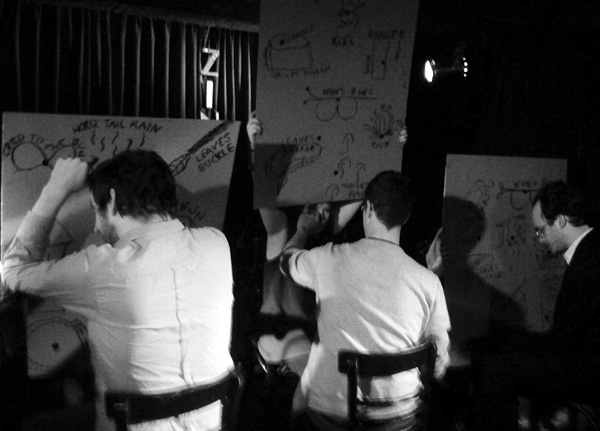
FAAL-E-FF, THE AUTO-RHAPSODOMANCER
first performed on December 14, 2014
Zinc Bar, New York, NY
performed once in 2014
FARNOOSH FATHI
New York, NY
FAAL-E-FF, THE AUTO-RHAPSODOMANCER
FARNOOSH FATHI
The inspiration for this performance comes from the ancient practice of rhapsodomancy—divination through poetry or song—and specifically from the popular Persian tradition of reading Hafez’s poetry, known as Faal-e-Hafez (faal is Farsi for “divination” or “fortune”), as a means of divination. If you visit Shiraz, especially anywhere near Hafez’s tomb, you’ll likely encounter people (often children) with canaries who, for a couple dollars (and once you’ve thought up your question or wish to yourself) will pick out with their beaks, from hundreds of tiny scrolls, a poem from Hafez that becomes your faal. The FFFAAL Auto-Rhapsodomancer consists of three cardboard divination stations with two chairs per station, one in front of the “oracular divide” and one behind. Six poems are taped to the back of the divide, where the one who delivers the faal sits. On the front side of the divide, drawn in charcoal on the cardboard, are six images with names. Each image has a hole in it—these are the poetry glory holes through which you hear and speak the faal. Each image corresponds to a particular poem it appears in; for example, the image of the “dandelion door” corresponds to a poem (“Home State”) in which it appears. To receive your reading, you let some burning feeling or question arise in silence for you. Once it has, you poke your finger through one of the holes, and the person on the other side reads you the corresponding poem.
The purpose of this simple performance machine is, first, a more complete engagement of the text (you read it—you see the poem—and you are also read to—you hear the poem) and this is done with the ease of relative anonymity (the board is between participants and those remaining in the audience see no faces). You are divined and you divinate too, which not only approximates the actual process of reading, but amplifies it. That is, the purpose of performing poetry as rhapsodomancy is presenting poems as mediums of divination, as potential fortunes. It says, these poems are intended to serve you; they exist primarily for your personal interpretation. What you want to read in it, finding what connects or resonates for you is the point and in fact, whatever you have—a private concern, an ineffable feeling—a poem in its capaciousness and generosity can engage and in the exchange you find yourself holding your own experience differently. I imagine that this is actually what we do naturally (consciously or subconsciously) when we pick up a book of poems and flip to a random page and decide if it speaks to us, or turn to a book we love. So this rhapsodomancy machine works to acknowledge, allow and make overt that process.
Beginning with myself and one volunteer, this machine starts a chain. The one who has received a faal has the option of coming behind the board and offering a faal for another audience member. Soon enough, the auto-rhapsodomancer is in full rotation, which, for the poet (reclined for a moment in the audience) can just watch.